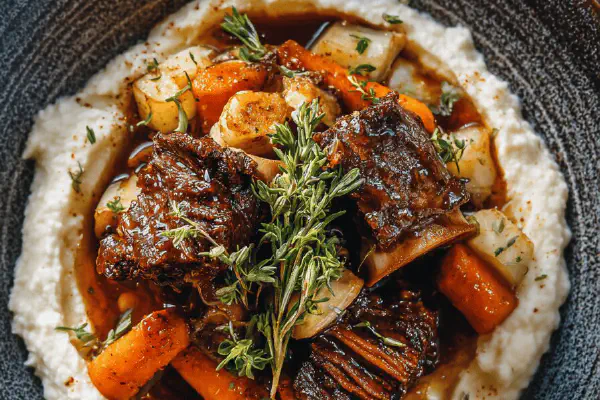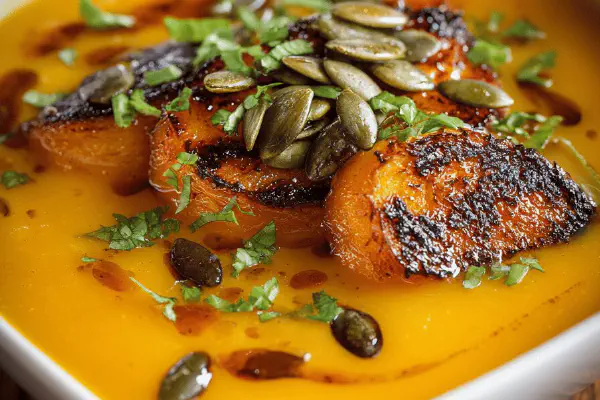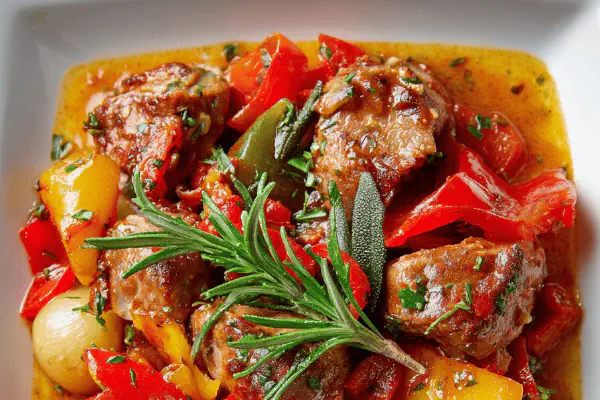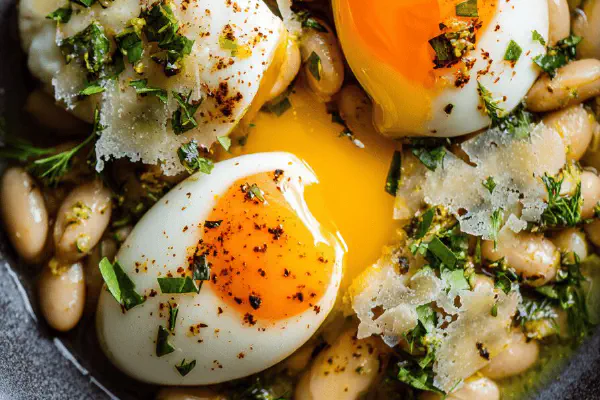Beef Cappuccino with Parsnip Mousse

By Emma
Certified Culinary Professional
Ingredients
PARSNIP MOUSSE
- 480 ml (2 cups minus 1 tbsp) parsnips peeled, cut into cubes
- 12 ml (3 tsp) butter
- 130 ml (1/2 cup plus 2 tbsp) whole milk
- 130 ml (1/2 cup plus 2 tbsp) heavy cream 35%, whipped
BEEF BROTH
- 1.2 kg (2.5 lb) beef marrow bones
- 2 large carrots, cut into chunks
- 2 turnips, peeled and quartered (swap celery)
- 2 cloves garlic, smashed
- 1 medium onion, quartered
- 25 ml (1.5 tbsp) olive oil
- 1.4 L (5.5 cups) water
About the ingredients
Method
PARSNIP MOUSSE
- 1. Toss parsnips in cold water, salt lightly, bring to boil. Simmer until fork slides in with zero resistance. No mush; tender but intact.
- 2. Drain well. Blend warm with butter until silky. Drizzle milk slowly while blending; texture should thicken but stay spoonable. Cool in fridge minimum 40 minutes—chilling tightens flavors and firms body.
- 3. Whip cream medium-firm, do not overbeat or it breaks. Fold the cream into cold parsnip puree gently—folding for air, not mixing to liquid. The mousse should feel light but still hold shape. Chill until needed.
BEEF BROTH
- 4. Place oven rack mid-level. Preheat oven to 250 °C (480 °F). Line a tray with paper towels to catch splatter.
- 5. Toss bones, carrots, turnips, garlic, onion, olive oil, and a good pinch of salt on rimmed tray. Space bones for max browning. Roast 40 to 50 minutes, turning every 12 minutes for even roast. Aim for deep golden crust, slight charring but not black. Smell shifts to nutty roasted meat aroma.
- 6. Transfer all to heavy stockpot, add cold water. Bring slowly to boil then reduce to simmer. Maintain gentle bubbles (not full boil) for 35-40 minutes. Skim foam and impurities often. Rich flavor develops with glossy sheen on broth surface.
- 7. Strain broth through fine mesh. Discard solids. Cool slightly, then degrease by removing fat layer or chilling broth until fat solidifies, then scrape off. Avoid watery broth by maintaining simmer, not rapid boil.
ASSEMBLY
- 8. Warm parsnip mousse gently in microwave in 15-second bursts, stirring between. Should be warm, not hot. Mousse collapses if overheated.
- 9. Ladle hot broth into cappuccino cups until 3/4 full. Spoon mousse on top as 'foam'. Grind fresh black pepper over mousse crown. Tiny spoon needed—sip broth, dollop mousse together.
- Serve immediately. Watch mousse texture—too cold is stiff, too hot liquefies. Broth must be clear but rich, no cloudiness.
NOTES
- Bone roasting tricks: high heat then slow simmer releases gelatin better. If bones not browned, broth tastes flat. Parsnip substitutions: rutabaga or sunchoke add interesting earthiness. Turnips instead of celery lighten broth complexity.
- If pressed for time, roast bones lower temp longer but expect less color. If mousse too thin, chill longer or fold in more cream. Overwhip cream? Rescue by adding cold parsnip puree back in gently.
- No beef marrow on hand? Use chicken bones with short roast but add umami boosts like dried mushrooms.
- Remember—smell guides doneness in roasting; broth shimmer signals ready; mousse texture changes with temperature.
Cooking tips
Chef's notes
- 💡 Parsnips start in cold salted water; bring to boil slowly. Simmer so fork slides in, no mush; keep tender but intact or puree dulls. Blend warm with butter, drip milk slowly to thicken but keep spoonable. Chill minimum 40 mins; firming purees controls mousse hold. Whip cream medium-firm, not stiff or crusty. Fold gentle to keep air. Mousse cold or falls apart. Microwave warming in short bursts only; mousse breaks if too hot.
- 💡 Roast bones on paper towel lined tray spaced well for max browning; turn every dozen minutes to avoid black spots. Bone edges should caramelize, crackle lightly, smell nutty-roasted. Dark but not charred. High heat 250°C; don’t rush or broth ends flat. Roast 40-50 mins depending on oven; smell is best doneness cue. Transfer bones and veg to pot, cover cold water, bring slow boil then simmer low. Skim often; foam ruins clarity and taste.
- 💡 Use turnips instead celery for cleaner sweetness, earthiness. Garlic and onion add balance but never raw or broth turns bitter. Olive oil—not generic vegetable—gives aroma boost. Salt early during roasting; no late salting or broth tastes under-seasoned. Water level covers bones, exact not critical; visual guide better. Simmer gently 35-40 mins; rolling boil clouds broth messes fat uneaten. Strain fine mesh; discard solids. Degrease by chilling or skimming fat for clean mouthfeel.
- 💡 Mousse and broth temps matter—mousse warm, not hot or collapsed; broth hot but clear. Assemble fast. Fresh cracked pepper on mousse crown adds sharp lift. Small spoon for dollop plus sip combo. If broth tastes weak, extend roast time for bones or add dried mushroom powder as umami. Mushrooms add depth but watch overpower. Mousse thin? Chill longer or fold in more cream gently. Overwhip cream? Rescue by blending back cold puree slowly.
- 💡 Smells guide doneness at every step—roast bones nutty and crackling, broth surface sheen eyecatching, parsnip mousse holding light peaks but no graininess. Texture cues trump timer. Skim foam often. Don’t overcook parsnips; puree texture dulls. Chilling puree firm helps folding air. Bone roasting high heat then slow simmer releases gelatin. Plan timing loosely; rely on sight and smell more than clock.
Common questions
How to avoid watery broth?
Simmer only gentle bubbles; no full boil or broth clouds. Skim foam often. Roast bones deep golden but not charred. Using cold water when adding to pot. Patience key here. Foam messes taste and texture. Watch sheen on surface for done.
Parsnip mousse too thin?
Chill puree longer so it firms. Fold in more whipped cream slowly to thicken mousse without breaking air. Avoid adding too much milk when blending or puree thins out. Whip cream medium-firm, not stiff. Gentle folding keeps mousse light but thick.
Any swaps for beef marrow bones?
Chicken bones work for lighter broth but shorter roast time. Veal bones okay too; less intense flavor. If no marrow bones, add dried mushrooms or mushroom powder to boost umami. Avoid raw garlic in broth to prevent bitterness. Use what available but watch flavors change.
Best way to store leftover broth and mousse?
Broth refrigerate tight container; skim fat layer after chilling or remove with spoon. Mousse keep cold, seal airtight; reheat gently in microwave short bursts, stirring frequently. Consume mousse within 2 days; broth up to 3 days. Freeze broth if needed; mousse not recommended frozen.



